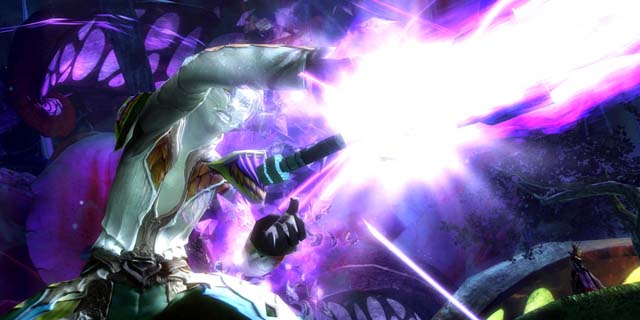
MMOs are too large in scope to be covered by our traditional review process. So here’s what we’re doing instead: giving you a “first draft” with thoughts from the initial days of a world, then circling back in a few weeks with a fleshed-out look at the final game and high-level experience.
The term “free-to-play” is a bit of a misnomer when it comes to MMOs these days. Many of them are initially free, though most often, you cannot have the same experience without paying for something. Often dropping a monthly fee and going for microtransactions is seen by the community as the last resort of an unsuccessful game. In my experience, this is not always true, as I know of several games that have done this with great success.
With Guild Wars 2, the team has designed the game with a hybrid business model in mind. There is a microtransaction store, where the items available are useful but not required, often related to bank and bag space or cosmetic items like mini pets. But since most of ArenaNet’s revenue comes from the flat purchase cost of the game, there is no reason to extend the amount of time spent in the game except for gameplay reasons. Often, MMOs might force unnecessarily-long travel times on players, simply to increase the length of time spent in the world. Over the course of years, an extra 30 seconds traveling from location to location adds up. The same is true of leveling speed.
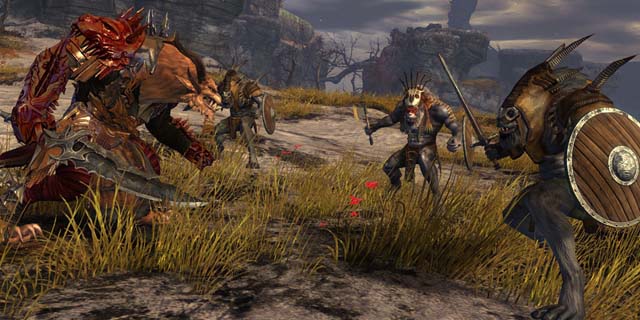
Once you discover an area in Guild Wars 2, it is incredibly simple to fast travel back to it, spending some in-game currency to do so. Exploring an area the first time is a great experience, and makes the world feel bigger. Though returning to it carries no feeling of accomplishment, and the ability to quickly move around helps keep you interested in finding more new areas. The leveling speed is also fairly quick, though slow enough that it feels like an accomplishment.
The first thing you will choose in Guild Wars 2 is your home server. This is no different from any other MMO: the characters you create will exist on this server. Currently, you can travel between servers, though eventually this will be a paid service. Having it free helps with balancing populations between worlds and meeting up with friends.
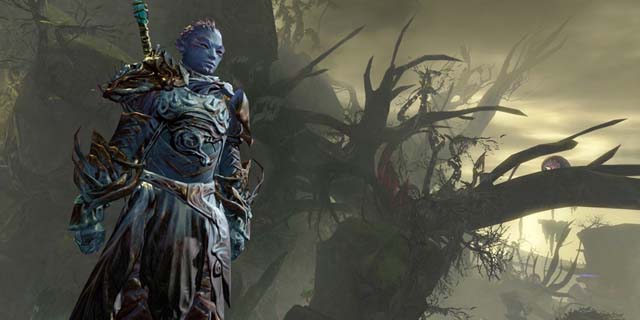
Character creation is in the middle of the customization pack. It has far more options than World of Warcraft, but don’t expect Champions Online levels of complexity here. Each character begins by choosing a race. Each race does look unique, though they do tend to fit into tropes of the genre (with the exception of humans).
The Norn are large humanoids from the mountains. They’re similar to humans, though much bigger and taller. Their home city has a Norse feel to it.
The Charr, who were antagonists in the original game, are feline warriors with bovine horns. Don’t expect a typical cat-person race here, as they’re very much designed to be warriors and “cute” isn’t a word I’d use to describe them. Their cities are designed with a steampunk style.
The Asura are short humanoids with smooth skin. They’re intelligent, and in the game lore, are responsible for much of the technology in the game involving fast travel and portals.
The Sylvari are plant-based, and their home city is a large tree. They are a bit mysterious. They had no presence in the first game.
The Humans in Guild Wars 2 are unique among fantasy games; it is typical for the human race to be fairly dominant in the game world, but this is not true here. The humans are a conquered race, and have been pushed back to a single kingdom.
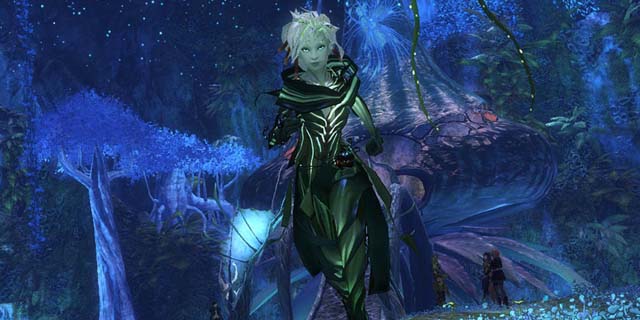
Each character then chooses a profession:
Mesmer is a magical class using illusion as its primary skill. One of the signature classes of Guild Wars, it differs from the usual RPG classes.
Necromancer is, as you might expect, a magic profession based around summoning the dead. It also focuses on life drain.
Elementalist is your Mage class, based around dealing damage with spells.
Ranger is an archer class built around a pet. As you might expect, this class is designed around keeping enemies at a distance.
Engineer is somewhat similar to Ranger, though in place of the pet are turrets and devices. It has a steampunk style, much like the Charr cities.
Thief, a melee profession built around stealth and agility, is a staple of the fantasy RPG.
Warrior and Guardian are both melee classes with heavy armor, though the Guardian is more defensive, and the Warrior more offensive.
Most of these classes are either returning from Guild Wars or are RPG staples. The majority of my experience with the game is as an Engineer.
The final part of character creation has you answer several questions. These shape the future of your storyline, and decide which quests you will recieve as you play through the game. And of course, you choose a name.
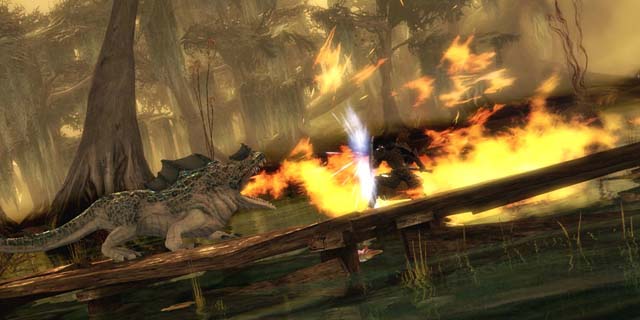
This game doesn’t really drag you through too many tutorials. That said, I found it really easy to get into, and I was left with few questions about how to play. I did find that the crafting system wasn’t overly obvious at first, though once I got close to the crafting trainers, an NPC was present to explain how it works.
ArenaNet and the game’s community have put together a comprehensive official wiki for the game, and using the /wiki command ingame will open a web browser. This is a very good way to handle documentation, especially with the ever-changing state of an MMO. I could see this becoming awkward on one screen, though, if you refer to it often.
It’s worth mentioning how weapon skills work: when you first use a weapon, you’ll only have one of your main skills available. As you use it, the next will eventually unlock, and so on, until you have four main skills. This acts both as a way to obtain your four main abilities, and to gradually introduce you to them. This is not a grind; you’ll get them all in five to ten minutes as you fight. It is important to note that you have different skills for each weapon type you can equip. Your other skills will be unlocked with skill points that are collected as you explore, and are based on your chosen profession.
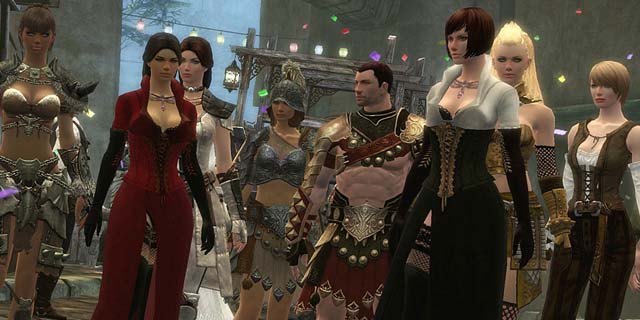
Combat in Guild Wars 2 is very much the same MMO combat we all know from other games, with a few changes. For one, your level will automatically adjust to the area you are playing in; you cannot overpower a zone simply by being a higher level. You’ll have access to higher-level gear and abilities, but it still won’t have you running around and taking things down in one hit.
The other major difference is dodging. Double-tapping in one direction will let you quickly dodge an incoming attack. This adds a bit more control over a battle, and removes some of the pure math from it. Many games implement dodging as a base percentage that is decided through gear stats. This has typically resulted in a battle consisting of a player and an enemy standing nose to nose wailing away with weapons and spells, letting the damage per second and hit points decide the outcome. While this is still a gear- and stat-based game, dodging gives you an extra out in a tough fight, and when timed right it can turn the tables in your favor. The combat feels fast and encourages movement with this system.
The combat doesn’t feel that different, though in an MMO, it’s often best to stick with a known quanitity. With engineer, I like the ability to “run and gun”, when my default shooting attack continues as I move around. (Though an engineer also wants to be sure the enemy stays within range of its stationary turrets.)
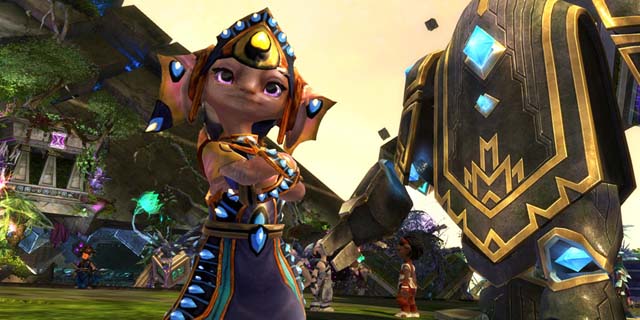
As I started playing, the first thing I noticed was the complete lack of the ubiquitous exclamation marks over NPCs. In fact, you’ll only ever have one real quest in the game, following your character’s storyline. All of the traditional MMO quests have been replaced by events. Some events are linked to an NPC and can only be completed once, as with a traditional quest. However, these have more than one goal that can be accomplished.
Often, it will be a choice between killing a number of enemies, gathering a number of items or completing a certain task. These are primarily intended to guide you through a zone and give you overall goals to achieve, often leading you to other events or locations. Other events simply occur at random, or on regular intervals. These can be completed by any number of players, and contributing players will recieve experience based on their participation.
Many games, World of Warcraft specifically, suffer from players wanting to be alone while questing. Quest targets, items, and escort NPCs were only available to one player at a time, causing players to avoid one another as much as possible. The same was true of crafting materials. In Guild Wars 2, none of this applies. Each player sees their own quest items. I can pick one up, and anyone following me can also pick one up. I can harvest a tree, and another player harvests that same tree. As a result, the game makes me want to be running around with as many players as possible, even if we aren’t in a group together. They are adding to my gameplay, not taking away from it.
At level 25, and I am fully enjoying my time with Guild Wars 2. The game makes minor changes to the traditional MMO gameplay that improve it immensely. Like World of Warcraft did when it released, this game takes the MMO formula and cuts out the parts that irritate players, expanding on the parts they love.



















